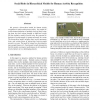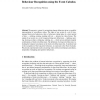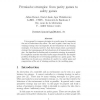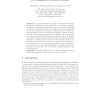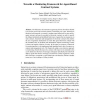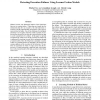117
click to vote
CVPR
2012
IEEE
13 years 3 months ago
2012
IEEE
We present a hierarchical model for human activity recognition in entire multi-person scenes. Our model describes human behaviour at multiple levels of detail, ranging from low-le...
103
click to vote
ICCV
2011
IEEE
14 years 29 days ago
2011
IEEE
In the security domain a key problem is identifying rare behaviours of interest. Training examples for these behaviours may or may not exist, and if they do exist there will be fe...
IFIP12
2009
14 years 10 months ago
2009
We present a system for recognising human behaviour given a symbolic representation of surveillance videos. The input of our system is a set of timestamped short-term behaviours, t...
114
click to vote
ITA
2002
15 years 19 days ago
2002
It is proposed to compare strategies in a parity game by comparing the sets of behaviours they allow. For such a game, there may be no winning strategy that encompasses all the be...
IPL
2008
15 years 28 days ago
2008
: We investigate weighted automata with discounting and their behaviours over semirings and finitely generated graded monoids. We characterize the discounted behaviours of weighted...
ENTCS
2010
15 years 1 months ago
2010
The crucial strength of the component paradigm lies in the possibility to encapsulate behaviours. In this work, we focus on the observable behaviour of composite components which ...
114
click to vote
ACSW
2006
15 years 2 months ago
2006
Computational grids are now widespread, but their large-scale behaviour is still poorly understood. We report on some calculations of loading, scaling and utilisation behaviours o...
PTS
2007
15 years 2 months ago
2007
In a component oriented approach, components are designed, developed and validated in order to be widely used. However one cannot always foresee which specific uses will be made o...
108
Voted
CIA
2008
Springer
15 years 2 months ago
2008
Springer
The behaviours of autonomous agents may deviate from those deemed to be for the good of the societal systems of which they are a part. Norms have therefore been proposed as a means...
113
click to vote
AAAI
2007
15 years 3 months ago
2007
reason with abstracted models of the behaviours they use to construct plans. When plans are turned into the instructions that drive an executive, the real behaviours interacting w...
